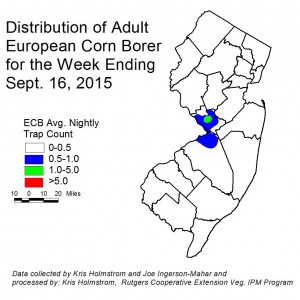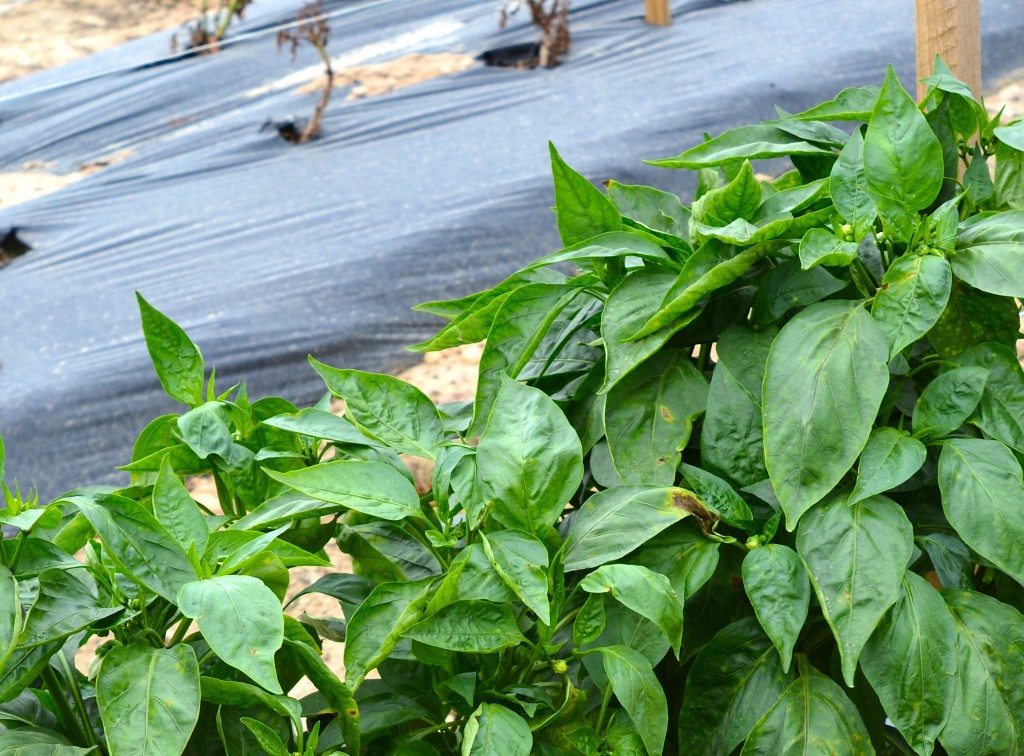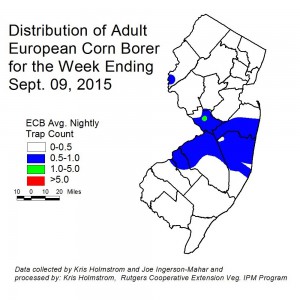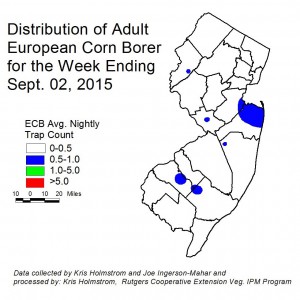- Downy mildew remains active on all cucurbit crops. All cucurbit growers should include downy as well as powdery mildew specific fungicides in their weekly maintenance sprays. Please remember different modes-of-Action (i.e., FRAC groups) to help manage fungicide resistance develop in both pathogens. To track the progress of CDM in the US please visit http://cdm.ipmpipe.org/
- There have been no new reports of late blight in New Jersey. Remember as fall approaches and night temperatures become cooler and light fogs begin to develop conditions for late blight development improve. All abandoned tomato blocks/fields need to be disked under as soon as harvesting is done or sprayed with gramoxone to kill all living foliage. To track late blight in the US please visit http://usablight.org/
- Downy mildew was reported on turnip greens this past week. The cool, damp mornings with lingering dew have been ideal for downy mildew development across many crops.
- Basil downy mildew remains active.
Vegetable Crops Edition
Seasonal updates and alerts on insects, diseases, and weeds impacting vegetable crops. New Jersey Commercial Vegetable Production Recommendations updates between annual publication issues are included.
Subscriptions are available via EMAIL and RSS.
Quick Links:
 NJ Commercial Vegetable Production Recommendations
NJ Commercial Vegetable Production Recommendations
 Rutgers Weather Forecasting - Meteorological Information important to commercial agriculture.
Rutgers Weather Forecasting - Meteorological Information important to commercial agriculture.
Vegetable Disease Briefs – 9/21/15
Veg IPM Update: Week Ending 9/16/15
Sweet Corn
Only a scattering of European corn borer (ECB) moths are being captured now, with somewhat more consistent catches in Mercer County (see ECB map). Damage from this pest is largely being overshadowed by that of the fall armyworm.
As always, consider treating when the number of infested plants in a 50 plant sample exceeds 12%. Any planting remaining at or above threshold as it proceeds to full tassel should be treated, as this is the last stage at which ECB larvae will be exposed and vulnerable to insecticidal sprays.
See the 2015 Commercial Vegetable Recommendations Guide for insecticide choices.
RAREC Variety Trials:
Disease-Resistant Hybrid Bell Pepper ‘Turnpike’
Phytophthora blight (P. capsici) and bacterial leaf spot (BLS) are the two greatest pathogen threats to pepper production in New Jersey. Articles in the Plant & Pest Advisory, such as Phytophthora Control During Wet Weather, Controlling Phytophthora Blight in Pepper, and Bacterial Leaf Spot Update, have talked about why growers are experiencing increasing crop losses due to P. capsici and BLS. Work on mitigating the impact of these pathogens has been on-going for decades at the Rutgers Agricultural Research and Extension Center. Among the many pepper varieties evaluated at the farm, the new Seminis hybrid, Turnpike, has generated excitement for its fruit quality, yield potential, and resistance against both Phytophthora blight as well as bacterial leaf spot races 0-5 and 7-9.
Phytophthora blight and bacterial leaf spot are issues for growers; Turnpike has performed well and looked strong in the test field. [Read more in American Vegetable Grower/Growing Produce]
Veg IPM Update: Week Ending 9/9/15
Sweet Corn
The second European corn borer (ECB) generation is lingering at low levels, primarily in central counties (see ECB map).
As always, consider treating when the number of infested plants in a 50 plant sample exceeds 12%. Any planting remaining at or above threshold as it proceeds to full tassel should be treated, as this is the last stage at which ECB larvae will be exposed and vulnerable to insecticidal sprays.
See the 2015 Commercial Vegetable Recommendations Guide for insecticide choices.
Late Blight Found on Tomato: Morris County – 9/2/15
Late blight has been found in a small tomato planting near Chester in Morris County. This is the third late blight report this growing season in New Jersey and the first since mid-August. Although the weather around NJ has been hot and dry the past few weeks, morning dews and fogs are slowly starting to roll in with Autumn around the corner. All tomato growers should scout their fields on a regular basis. Early-season plantings that have been abandoned need to remain on your radar screen, especially if they haven’t been mowed off or hit with gramoxone to kill all living plant material. To track late blight in the US please visit http://usablight.org/
Veg IPM Update: Week Ending 9/2/15
Sweet Corn
The second European corn borer (ECB) generation continues to be weak. Catches are limited to scattered pockets registering more than one moth per week (see ECB map).
As always, consider treating when the number of infested plants in a 50 plant sample exceeds 12%. Any planting remaining at or above threshold as it proceeds to full tassel should be treated, as this is the last stage at which ECB larvae will be exposed and vulnerable to insecticidal sprays.
See the 2015 Commercial Vegetable Recommendations Guide for insecticide choices.





